Savvas Learning Co Geometry Student Edition Chapter 2 Reasoning And Proof Exercise 2.2 Conditional Statement
Page 92 Exercise 1 Problem 1
Given: A statement Residents of Key West live in Florida.
To Find – What is the hypothesis and the conclusion of the following statement and Write it as a conditional.
Given
A statement: Residents of Key West live in Florida.
The hypothesis: The people are residents of Key West.
The conclusion: They live in Florida.
Condition for the given statement: If people are residents of Key West, then they live in Florida.
The hypothesis: The people are residents of Key West.
The conclusion: They live in Florida.
Condition for the given statement: If people are residents of Key West, then they live in Florida.
Page 92 Exercise 2 Problem 2
Given: A condition If a figure is a rectangle with sides 2cm and 3cm, then it has a perimeter of 10cm.
To Find – Write if the given condition is true or false and what are the converse, inverse, and contrapositive of the condition, what are the truth values of each.
If a figure is a rectangle with sides 2cm, 3cm, then it has a perimeter of 10cm
The given statement is true, P = 2(2 + 3) P = 2(5) = 10
The converse is found by exchanging the hypothesis and the conclusion (q→p)
If a figure is a rectangle and has a perimeter of 10cm, then it has sides of 2cm,3cm
We note that this is false since rectangle with sides 1cm, 4cm has a perimeter of 10cm as a counterexample.
The inverse is found by negating both the hypothesis and the conclusion of the condition.
If a figure is a rectangle and does not have sides, 2cm,3cm then it does not have a perimeter of 10cm.
We note that this is false since the rectangle with sides 1cm, 4cm has a perimeter of 10cm as a counterexample.
The contrapositive is found by negating both the hypothesis and the conclusion of the converse.
If a figure is a rectangle and does not have a perimeter 10cm, then it does not have sides of 2cm,3cm.
We note that this is true since the perimeter of a rectangle has sides 2cm,3cm is 10cm.
The conditional and contrapositive are both true.
The conditional and contrapositive are both true.
Converse: If a figure is a rectangle and has a perimeter of 10cm then it has sides of 2cm,3cm
Inverse: If a figure is a rectangle and does not have sides 2cm,3cm then it does not have a perimeter of 10cm
Contrapositive: If a figure is a rectangle and does not have a perimeter 10cm, then it does not have sides of 2cm,3cm
Page 92 Exercise 3 Problem 3
Given: Your classmate rewrote the statement “You jog every Sunday” as the following conditional. If you jog, then it is Sunday.
To Find – What is your classmate’s error? Correct it.
Given
The statement:
If you jog, then it is Sunday
The statement is false.
My classmate switched the hypothesis and conclusion.
The correct hypothesis:
If it is Sunday.
The correct conclusion:
Then you should jog.
The statement should actually read as
If it is Sunday, then you jog.
My classmate switched the hypothesis and conclusion. The statement should actually read as If it is Sunday, then you jog.
Page 92 Exercise 4 Problem 4
Given: A conditional statement and its converse are both true.
To Find – What are the truth values of the contrapositive and inverse? How do you know?
Given
The statement:
A conditional statement and its converse are both true.
It must be true since the conditional and contrapositive have the same truth value and the inverse and converse have the same truth value.
Contrapositive: ~q →´
Converse: p → q
The answer is True, the conditional and contrapositive have the same truth value and the inverse and converse have the same truth value.
Page 93 Exercise 5 Problem 5
Given: A condition If a figure is a rectangle, then it has four sides.
To Find – Identify the hypothesis and conclusion of each conditional.
Given
A condition: If a figure is a rectangle, then it has four sides.
Look for the word ‘if’. The hypothesis will follow.
So, the hypothesis is:
A figure is a rectangle.
Look for the word ‘then’. The conclusion will follow.
So, the conclusion is:
It has four sides.
The hypothesis is: a figure is a rectangle. The conclusion is: it has four sides.
Page 93 Exercise 6 Problem 6
Given: A statement – Hank Aaron broke Babe Ruth’s home-run record.
To Find – Write the sentence as a conditional.
Here the hypothesis and the conclusion are
Hypothesis – Hank Aaron broke Babe Ruth’s home-run record.
Conclusion – He is the record holder
So the conditional statement will be – If Hank Aaron broke Babe Ruth’s home-run record, then he is the record holder.
The conditional statement for the statement “Hank Aaron broke Babe Ruth’s home-run record” is “If Hank Aaron broke Babe Ruth’s home-run record, then he is the record holder.”
Page 93 Exercise 7 Problem 7
Given: 3x − 7 = 14 implies that 3x = 21
To Find – Write the sentence as a conditional.
Here the hypothesis and the conclusion are
Hypothesis – 3x−7 = 14
Conclusion – 3x = 21
So the conditional statement will be, “If 3x − 7 = 14 , then 3x = 21 ”
The conditional statement for ” 3x − 7 = 14 implies that 3x = 21 ” is “If 3x−7=14 , then 3x = 21 “
Page 93 Exercise 8 Problem 8
Given:
A statement – A point in the first quadrant has two positive coordinates.
To Find – Write the sentence as a conditional.
Here the hypothesis and the conclusion are
Hypothesis – A point in the first quadrant
Conclusion – Has two positive coordinates
So the conditional statement will be – If a point is in the first quadrant, then it has two positive coordinates.
The conditional statement for “A point in the first quadrant has two positive coordinates.” is “If a point is in the first quadrant, then it has two positive coordinates.”
Page 93 Exercise 9 Problem 9
Given:
A statement – A point in the first quadrant has two positive coordinates.
To find – Write the sentence as a conditional.
Here the hypothesis and the conclusion will be.
Hypothesis – A point in the first quadrant
Conclusion – has two positive coordinates
So the conditional statement will be “If a point is in the first quadrant, then it has two positive coordinates.”
The conditional statement for “A point in the first quadrant has two positive coordinates.” is “If a point is in the first quadrant, then it has two positive coordinates.”
Page 93 Exercise 10 Problem 10
Given: A Venn diagram
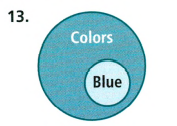
To find – Write the Venn diagram as a conditional.
Here we can see that the smaller blue circle is within the large circle labeled “colors”, so we can identify that anything that is blue will have a color to it.
So the conditional statement will be – If something is blue then it has a colour
The conditional for the Venn diagram below is, “If something is blue, then it has a color”
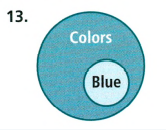
Page 93 Exercise 11 Problem 11
Given: A Venn diagram
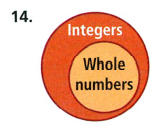
To Find – Write the Venn diagram as a conditional.
As the circle of whole numbers is within the circle for integers, so it implies that all whole numbers are also integers.
So the conditional statement will be – If a number is a whole number, then it is also an integer
The conditional statement for the Venn diagram given below is “If a number is a whole number, then it is also an integer.”
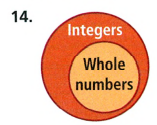
Page 93 Exercise 12 Problem 12
Given: A Venn diagram
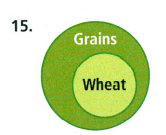
To Find – Write a conditional statement that the Venn diagram illustrates.
In the Venn diagram, we can see that the circle labeled wheat is within the circle labeled grains, so we can conclude that anything that is wheat is also a grain.
So the conditional statement will be – If anything is wheat, then it is also a grain.
The conditional statement that the Venn diagram illustrates is, “If anything is wheat, then it is also a grain.”
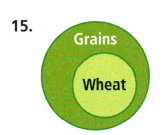
Page 93 Exercise 13 Problem 13
Given: A conditional – If a polygon has eight sides, then it is an octagon.
To find – Determine if the conditional is true or false.
If it is false, find a counterexample.
By the definition, a polygon that has 8 sides is an octagon, thus.
The conditional is true. A polygon with 8 sides is known as an octagon.
The conditional, “If a polygon has eight sides, then it is an octagon.” is true.
Page 93 Exercise 14 Problem 14
Given: A conditional – If an angle measures 80, then it is acute.
To find – Determine if the conditional is true or false. If it is false, find a counterexample.
By the definition of the acute angle, we get that 80 degrees is an acute angle.
So the conditional is true. All acute angles lie between 0 degrees to 90 degrees.
The conditional, “If an angle measures 80, then it is acute.” is true. All acute angles lie between 0 degrees to 90 degrees.
Page 93 Exercise 15 Problem 15
Given: A statement – Pianists are musicians.
To Find – Write the converse, inverse, and contrapositive of the given conditional statement.
Determine the truth value of all four statements. If a statement is false, give a counterexample.
We have, Pianists are musicians.
First, we will write the conditional statement.
Conditional: If you are a pianist then you are a musician.
Hypothesis: You are a pianist
Conclusion: You are a musician
The conditional statement is true.
Now we write the converse by interchanging the hypothesis and conclusion of conditional
Converse: If you are a musician, then you are a pianist
The converse is false because there are other types of musicians than pianists (for eg. violinists, cellists)
Now we write the inverse by negating the hypothesis and conclusion of conditional.
Inverse: If you are not a pianist, then you are not a musician.
The inverse is false because you can be a musician even if you are not a pianist.
Now we write the contrapositive by interchanging the hypothesis and conclusion of the inverse
Contrapositive: If you are not a musician, then you are not a pianist.
The contrapositive statement is true because you can not be a pianist if you are not a musician.
The conditional, converse, inverse, and contrapositive of the statement, “Pianists are musicians” are.
Conditional: If you are a pianist then you are a musician.
The conditional statement is true.
Converse: If you are a musician, then you are a pianist.
The converse is false because there are other types of musicians than pianists (for eg. violinists, cellists).
Inverse: If you are not a pianist, then you are not a musician.
The inverse is false because you can be a musician even if you are not a pianist.
Contrapositive: If you are not a musician, then you are not a pianist.
The contrapositive statement is true.
Page 93 Exercise 16 Problem 16
Given: A statement – If 4x + 8 = 28 , then x = 5
To find – Write the converse, inverse, and contrapositive of the given conditional statement.
Determine the truth value of all four statements. If a statement is false, give a counterexample.
We have, If 4x + 8 = 28 , then x = 5
Hypothesis- 4x + 8 = 28
Conclusion – x = 5
First, let us calculate the value of x
⇒ 4x + 8 = 28
⇒ 4x = 20
⇒ x = 5
Conditional: If 4x + 28 = 28 then x = 5
The conditional is true because x = 5 is the solution of the equation when solved.
Now we write the converse by interchanging the hypothesis and conclusion of conditional.
Converse: If x = 5 , then 4x + 8 = 28
The converse is true because x = 5 satisfies the equation.
Now we write the inverse by negating the hypothesis and conclusion of the conditional.
Inverse: If 4x + 28 ≠ 28 , then x ≠ 5
The inverse is true because x = 5 satisfies the related equation.
Now we write the contrapositive by interchanging the hypothesis and conclusion of the inverse.
Contrapositive: If x ≠ 5, then 4x + 8 ≠ 28
The contrapositive is true because x = 5 satisfies the equation
The conditional, converse, inverse, and contrapositive of the statement, “If 4x + 8 = 28 , then x = 5 ” are
Conditional: If 4x + 8 = 28 , then x = 5
The conditional is true.
Converse: If x = 5 , then 4x + 8 = 28
The converse is true.
Inverse: If 4x + 8 ≠ 28 , then x ≠ 5
The inverse is true.
Contrapositive: If x≠ 5 , then 4x + 8 ≠ 28
The contrapositive is true.
Page 93 Exercise 17 Problem 17
Given:
A statement – Odd natural numbers less than 8 are prime.
To Find – Write the converse, inverse, and contrapositive of the given conditional statement.
Determine the truth value of all four statements. If a statement is false, give a counterexample.
We have a statement, “Odd natural numbers less than 8 are prime.”
Hypothesis: an odd natural number less than 8
Conclusion: It is prime.
Conditional: If a number is an odd natural number less than 8, then it is prime.
The conditional is true because 3, 5, 7 are odd natural numbers and are also prime.
Converse: If a number is prime, then it is an odd natural number less than 8.
The converse is false because 13 is a prime number that is greater than 8.
Inverse: If a number is not an odd natural number less than 8, then it is not prime.
The inverse is false as 13 is a prime number greater than 8.
Contrapositive: If a number is not prime, then it is not an odd natural number less than 8.
The contrapositive is true because all prime numbers less than 8 are odd.
The conditional, converse, inverse, and contrapositive of the statement, “Odd natural numbers less than 8 are prime” are
Conditional: If a number is an odd natural number less than 8, then it is prime.
The conditional is true.
Converse: If a number is prime, then it is an odd natural number less than 8.
The converse is false because 13 is a prime number greater than 8.
Inverse: If a number is not an odd natural number less than 8, then it is not prime.
The inverse is false because 13 is not an odd natural number less than but it is prime.
Contrapositive: If a number is not prime, then it is not an odd natural number less than 8.
The contrapositive is true.
Page 93 Exercise 18 Problem 18
Given: A statement – Two lines that lie in the same plane are coplanar.
To find – Write the converse, inverse, and contrapositive of the given conditional statement.
Determine the truth value of all four statements.
If a statement is false, give a counter example.
We have, Two lines that lie in the same plane are coplanar.
Hypothesis: Two lines lie in the same plane
Conclusion: The lines are coplanar
Conditional: If two lines lie in the same plane, then they are coplanar.
The conditional statement is true.
We write converse by exchanging hypothesis and conclusion of conditional.
Converse: If two lines are coplanar, then they lie in the same plane.
The converse statement is true.
We write inverse by negating the hypothesis and conclusion of conditional.
Inverse: If two lines don’t lie in the same plane, then they are not coplanar.
The inverse statement is true.
We write contrapositive by exchanging the hypothesis and conclusion of the inverse statement.
Contrapositive: If two lines are not coplanar, then they don’t lie in the same plane.
The contrapositive is true.
The conditional, converse, inverse, and contrapositive of the statement, “Two lines that lie in the same plane are coplanar.” are
Conditional: If two lines lie in the same plane, then they are coplanar.
The conditional statement is true.
Converse: If two lines are coplanar, then they lie in the same plane.
The converse statement is true.
Inverse: If two lines don’t lie in the same plane, then they are not coplanar.
The inverse statement is true.
Contrapositive: If two lines are not coplanar, then they don’t lie in the same plane.
The contrapositive statement is true.
Page 94 Exercise 19 Problem 19
Given:
A statement- An event with probability 1 is certain to occur.
To Find – Write the statement as a conditional
We have, An event with probability 1 is certain to occur.
Hypothesis – An event has a probability of 1
Conclusion – The event is certain to occur
The conditional is an if-then statement so the conditional statement will be,
If an event has a probability of 1, then the event is certain to occur.
The conditional statement for the statement, “An event with probability 1 is certain to occur.” is “If an event has a probability of 1, then the event is certain to occur.”
Page 94 Exercise 20 Problem 20
Given: x = 2, x2= 4
To Find – Conditional and contrapositive both are true or not.
Use the basic concepts of reasoning.
If x = 2 , on squaring both sides then we get
⇒ x2 = 4
Therefore, the conditional statement is true.
Now, if x2 ≠ 4 , then we get ⇒ x ≠ 2
Therefore, the contrapositive statement is also true.
Another example in which both conditional and contrapositive statements are true is if x = 3, then x2 = 9.
Both conditional and contrapositive statements are true.
Page 94 Exercise 21 Problem 21
Given: Conditional statement.
To find – write two conditional statements in which one is true and another is false.
Use the basic concepts of reasoning.
Statement (A): If x = 3 , then x2 = 9.
If x = 3, on squaring both the sides then we get, ⇒ x2 = 9
This statement is conditionally true.
Statement (B): “If you get a good score in the entrance exam then you will not get the scholarship”.
This statement is not conditionally true because generally if the candidate gets good marks in the entrance exam then he will definitely get the scholarship for study.
The statement (A) is conditionally true.
The statement is ” if x = 3, then x2 = 9.”
The statement (B) is conditionally false. The statement is “If you get a good score in the entrance exam then you will not get the scholarship”.
Page 94 Exercise 22 Problem 22
Given: The given conditional statement is true.
To find – whether the contrapositive statement is true or false.
Use the basic concepts of reasoning.
Statement A: ” If the pitchers performed well, then there is the chance of winning the baseball game”.
The contrapositive statement A is true because if there is no chance of winning then the pitchers are not performing well while playing the game.
Statement B: ” If someone is a baseball player then someone is an athlete.
The contrapositive statement B is False because” if someone is not a baseball player, then it does not mean he is not an athlete”.
Both Natalie and Sean are correct. Because the contrapositive of statement A is true and contrapositive of statement B is false.
Page 94 Exercise 23 Problem 23
Given: Conditional statement.
To find – Venn diagram Use the basic concepts of the Venn diagram.
The given conditional statement is,” If an angle measures 100 , then it is obtuse”.
The Venn diagram can be represented as:
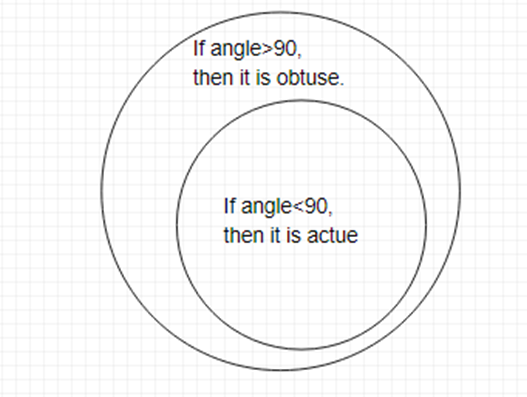
The Venn diagram which represents the given conditional state

Page 94 Exercise 24 Problem 24
Given: Conditional statement.
To find – Venn diagram Use the basic concepts of the Venn diagram.
The given conditional statement is, “If you are the captain of your team, then you are junior or senior”.
The Venn diagram can be represented as:
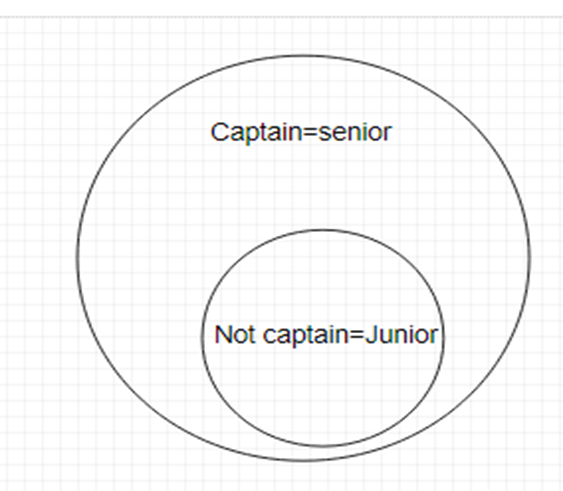
Venn diagram of the given conditional statement is: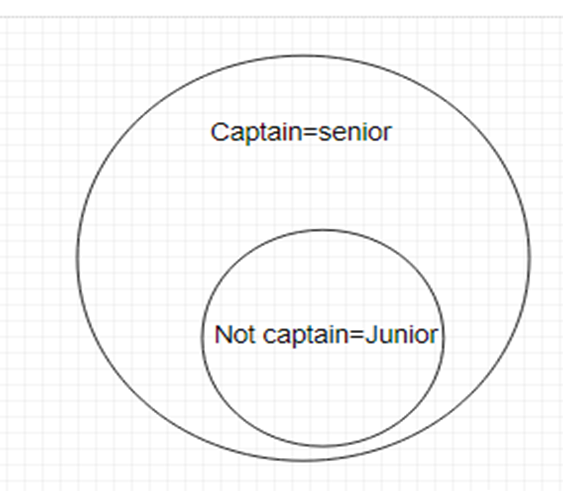
Page 94 Exercise 25 Problem 25
Given: If y is negative, then −y is positive.
To find – Converse statementUse the basic concepts of reasoning.
p: If y is negative, then −y is positive.
This statement is conditionally true.
Now we have to write the converse of this statement.
q: If −y is positive, then y is negative.
Let − y = 4
⇒ y = −4
Hence the converse statement is also true.
The converse statement is true.
Page 94 Exercise 26 Problem 26
Given: If x < 0 , then x3 < 0.
To find contrapositive statement.Use the basic concepts of reasoning.
p: If x < 0 , then x3 < 0 .
This statement is conditionally true.
Now if have to find the converse of this statement.
q: If x3 < 0 , then x < 0.
Let x =−2 which is less than 0
On cubing both the sides, then we get
⇒ x3
= −8 which is also less than 0.
⇒ If −2 < 0 , then (−2)3 < 0.
Hence the converse statement is also true.
The converse of the given statement is also true. The converse statement is,” if x < 0, then x3 < 0.
Page 94 Exercise 27 Problem 27
Given: If x < 0, then x2 > 0.
To find – Whether the converse is true or false.
Use the basic concept of reasoning.
p: If x < 0 , then x2 > 0.
This statement is conditionally true.
q: If x2 > 0, then x < 0.
Clearly, the converse part is not true.
Let us consider x2 = 4.
On square root both the sides then we get
⇒ x = −2,2
Here −2 < 0 but 2 > 0.
Therefore the converse of the statement is not true.
The converse of the statement is false.
Page 94 Exercise 28 Problem 28
Given: AdvertisementTo find a Conditional statement.
By using the basic concepts of reasoning we shall write the conditional statement.
The conditional statement can be written as,” If you wear snazzy sneakers, then you look cool”.
The conditional statement is,” If you wear snazzy sneakers, then you look cool”.
Page 94 Exercise 29 Problem 29
Given: Postulates.
To find a Conditional statement.
By using the basic concepts of reasoning we shall write the conditional statement.
The conditional statement can be written as,” If the two lines are intersecting lines, then they meet exactly at one point”.
The conditional is,” If the two lines are intersecting lines, then they meet exactly at one point“.
